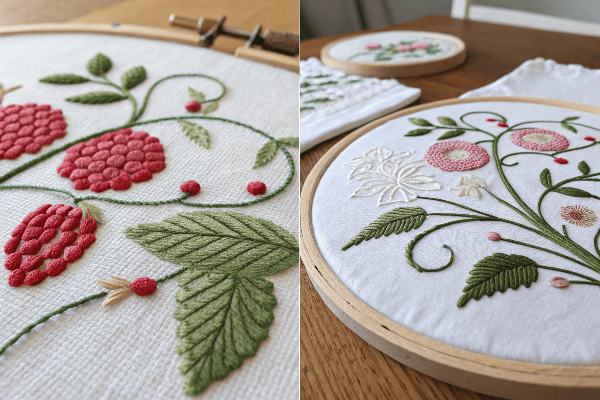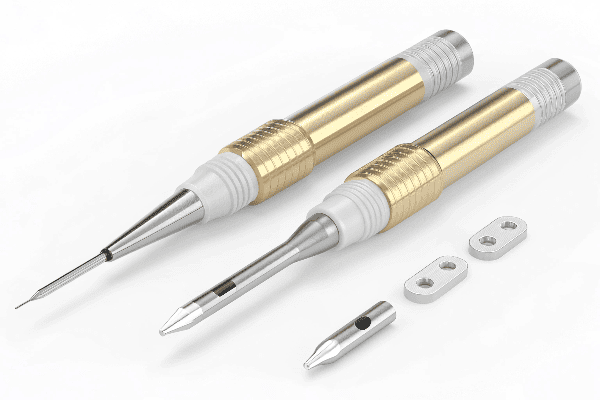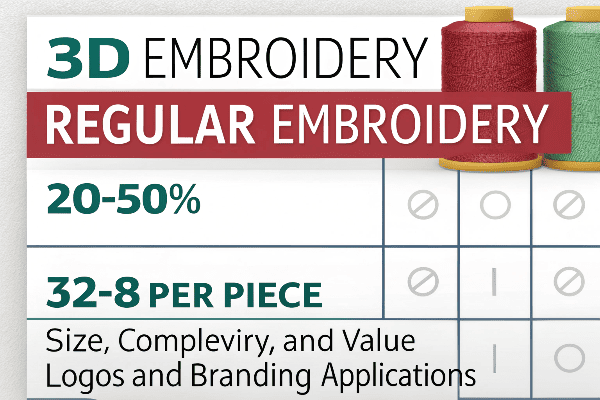Have you ever seen logos that pop out from hats and wondered how they achieve that eye-catching raised effect? I’ve spent years perfecting this technique at our manufacturing facility.
3D puff embroidery is a specialized embroidery technique that creates a raised, dimensional effect by stitching over foam material. This method adds texture, depth, and visual interest to designs, making logos and text literally stand out from the fabric surface.

After working with thousands of clients on custom apparel projects, I’ve seen firsthand how 3D puff embroidery can transform an ordinary garment into something truly special. Let me share what I’ve learned about this popular technique and why it might be perfect for your next project.
Table of Contents
- What is 3D puff embroidery?
- What is the difference between 3D puff embroidery and regular embroidery?
- What needle to use for 3D puff embroidery?
- Is 3D embroidery expensive?
- Conclusion
What is the difference between 3D puff embroidery and regular embroidery?
Ever received a cap with a flat embroidered logo and another with a logo that pops out? The difference you feel isn’t just your imagination – it’s the result of two distinct embroidery processes.
The main difference is that 3D puff embroidery uses a foam layer beneath the stitches to create elevation (3-6mm height), while regular embroidery lies flat against the fabric. 3D puff requires specialized digitizing, foam placement, and finishing techniques that regular embroidery doesn’t need.

The Technical Differences
As someone who oversees embroidery production daily at DECHENG, I can tell you that the differences between these techniques go far beyond just the visible result. Let me break down the key technical differences:
Production Process
The production process for 3D puff embroidery involves several steps that regular embroidery doesn’t require:
-
Design Preparation: 3D puff designs need special digitizing with considerations for foam placement, density settings, and underlay stitches. Regular embroidery digitizing is more straightforward.
-
Material Setup: For 3D puff, we must carefully position foam pieces on the fabric before the embroidery process begins. This foam (typically 2-3mm thick) is what creates the raised effect.
-
Stitch Execution: The machine first creates an outline, then we place the foam, and finally, the machine completes the design with dense stitches that compress and cover the foam. Regular embroidery simply follows the digitized pattern without these extra steps.
-
Finishing Work: After the embroidery is complete, excess foam must be carefully trimmed away from the edges of the design. Regular embroidery requires no such finishing work.
| Aspect | 3D Puff Embroidery | Regular Embroidery |
|---|---|---|
| Height | 3-6mm raised | Flat (0.5-1mm) |
| Materials | Requires foam backing | No additional materials |
| Digitizing | Complex, specialized settings | Standard digitizing |
| Production Time | 30-50% longer | Faster production |
| Suitable Applications | Logos, text, simple shapes | Versatile, complex designs |
| Durability | Generally less washable | More durable long-term |
Visual and Tactile Impact
In my experience working with clients, the decision between 3D puff and regular embroidery often comes down to the desired visual and tactile impact:
3D puff embroidery creates a bold, attention-grabbing effect that’s particularly popular for:
- Sports team logos on caps
- Brand names on promotional items
- Company logos on corporate apparel
- Athletic team numbers
Regular embroidery tends to be preferred for:
- Detailed, intricate designs
- Gradients and shading effects
- Designs that need to withstand frequent washing
- Formal or professional applications
Design Limitations
One aspect I always discuss with clients is the design limitations of 3D puff embroidery:
- Size Restrictions: The foam material works best with designs that aren’t too small (minimum elements usually 5-6mm wide) or too large (typically under 10cm).
- Detail Limitations: Very fine details are difficult to execute in 3D puff embroidery.
- Text Considerations: Text works well but needs to be an appropriate size – too small and the letters become difficult to read; too large and the foam may not hold its shape.
Last year, I worked with a client who wanted a very intricate logo with fine lines done in 3D puff. After showing them samples, we ended up using regular embroidery for the detailed parts and 3D puff only for the larger text elements. The hybrid approach gave them the best of both worlds.
Maintenance Differences
Another important consideration is how these different embroidery types hold up over time:
Regular embroidery generally withstands washing and wear better than 3D puff. The raised areas of 3D puff can be compressed or damaged with rough handling, though modern techniques have improved durability considerably.
For clients creating merchandise that will be frequently washed, I often recommend regular embroidery unless the dimensional effect is absolutely essential to their branding.
What needle to use for 3D puff embroidery?
Are your 3D puff embroidery projects turning out less than perfect? The needle you choose might be the culprit – I discovered this the hard way after years of trial and error.
For 3D puff embroidery, a sharp point needle size 75/11 is typically best. This needle type penetrates the foam cleanly without dragging or tearing it. For thicker foams or dense designs, a slightly larger 80/12 needle may be necessary to prevent breakage.

The Critical Role of Needle Selection
In my 15+ years of manufacturing experience, I’ve learned that needle selection1 can make or break a 3D puff embroidery2 project. The right needle ensures clean penetration through the foam, proper thread tension, and minimal machine issues.
Needle Types for 3D Puff Embroidery
There are several characteristics to consider when selecting needles for 3D puff work:
Point Type
The point type is perhaps the most critical factor:
| Point Type | Suitability for 3D Puff | Best Applications |
|---|---|---|
| Sharp (R) | Excellent | Most 3D puff projects, clean foam cutting |
| Light Ball (SES) | Good | Slightly stretchy fabrics with 3D puff |
| Medium Ball (SUK) | Fair | Only for very stretchy base fabrics |
| Ball Point (SPI) | Poor | Avoid for 3D puff work |
| Wedge Point | Specialized | Technical 3D applications only |
I remember a particular project where we were experiencing constant thread breaks on a 3D puff logo. After troubleshooting every other possible cause, we discovered the operator had loaded ball point needles rather than sharp needles. The simple switch to sharp points resolved the issue immediately.
Needle Size
Size matters significantly when working with foam:
- 75/11: This is my go-to size for most 3D puff projects. It’s strong enough to penetrate the foam but thin enough to avoid leaving visible holes.
- 80/12: For thicker foams (4mm+) or when using heavier threads, this slightly larger size helps prevent needle breaks.
- 70/10: Occasionally useful for very lightweight fabrics with thin foam, though more prone to breaking.
- 90/14: Sometimes necessary for extra thick applications, but can leave visible holes in the foam.
During a recent large order of 3D puff caps for a sports team, we found that the 75/11 needles were breaking frequently. The foam we were using was slightly denser than our usual stock. Switching to 80/12 needles solved the problem and allowed us to complete the order without further issues.
Needle Coating
Modern embroidery needles come with various coatings that can affect 3D puff performance:
- Chrome-plated: Standard needles that work well for most applications
- Titanium-coated: These more expensive needles offer extended life and better heat resistance, which can be beneficial for high-volume 3D puff production
- Non-stick coated: Helpful when using adhesive sprays to secure foam in place
Machine Settings Considerations
Beyond needle selection, certain machine adjustments are necessary when switching to 3D puff embroidery:
- Reduced Speed: We typically run our machines at 20-30% slower speeds for 3D puff to reduce stress on the needles
- Adjusted Tension: Thread tension often needs to be looser than for regular embroidery
- Increased Presser Foot Height: To accommodate the foam thickness
One technical trick we’ve developed is to slightly increase the needle bar height when doing extensive 3D puff work. This minor adjustment gives the needle more time to penetrate the foam cleanly, reducing strain and potential needle deflection.
Needle Maintenance for 3D Puff Work
Working with foam is harder on needles than regular embroidery. We’ve established these best practices at our facility:
- Change needles more frequently (approximately every 8-10 hours of 3D puff production)
- Listen for changes in machine sound that might indicate needle dullness
- Inspect needles under magnification for signs of wear or burrs
- Keep a dedicated set of needles specifically for 3D puff projects
While these practices add some cost, they save significantly more by preventing quality issues, reducing machine downtime, and ensuring consistent results across large orders.
Is 3D embroidery expensive?
Worried about blowing your budget on custom apparel? Many clients approach me with concerns about the cost of 3D embroidery before they understand the full picture.
3D embroidery typically costs 20-50% more than regular embroidery, with prices ranging from $2-8 per piece depending on size, complexity, and quantity. However, the enhanced visual impact and perceived value often justify the additional expense for logos and branding applications.

Breaking Down the Costs
Having managed thousands of embroidery projects, I can offer a transparent look at why 3D puff embroidery comes at a premium and what factors influence the final price.
Why 3D Puff Costs More
The higher cost of 3D puff embroidery stems from several factors:
Additional Materials
The foam material itself adds to the cost. While not expensive on its own (approximately $0.05-0.15 per logo), it represents an additional material that regular embroidery doesn’t require. For large production runs, this can add up significantly.
Increased Labor
3D puff embroidery requires more hands-on work than regular embroidery:
- Manual placement of foam pieces
- More complex machine setup
- Post-embroidery trimming and finishing
- Greater quality control requirements
In our facility, we’ve calculated that 3D puff embroidery requires approximately 30% more labor time per piece than standard embroidery.
Specialized Digitizing
Creating the digital file for 3D puff embroidery requires more skill and time:
| Digitizing Aspect | Regular Embroidery | 3D Puff Embroidery |
|---|---|---|
| Design Preparation | 30-60 minutes | 45-90 minutes |
| Stitch Types | Standard selection | Specialized settings |
| Test Runs Needed | 1-2 typically | 2-3 often required |
| Digitizing Cost | $15-50 | $25-75 |
Slower Production Speed
Our embroidery machines run at reduced speeds for 3D puff work:
- Regular embroidery: 700-1000 stitches per minute
- 3D puff embroidery: 500-700 stitches per minute
This reduction in speed means fewer pieces produced per hour, increasing the cost per item.
Cost Comparison Table
Based on our production data, here’s a typical cost comparison for different order quantities:
| Order Quantity | Regular Embroidery (per piece) | 3D Puff Embroidery (per piece) | Percentage Increase |
|---|---|---|---|
| 10-25 items | $5.00-7.00 | $7.50-10.00 | 40-50% |
| 26-100 items | $3.50-5.00 | $5.00-7.00 | 30-40% |
| 101-500 items | $2.50-3.50 | $3.50-5.00 | 25-35% |
| 501+ items | $1.75-2.50 | $2.50-3.75 | 20-30% |
Note: These prices reflect standard logo sizes (approximately 4" width) on common items like caps or polos.
Value Considerations
While 3D puff embroidery costs more, many of our clients find the investment worthwhile for specific applications:
Brand Perception
In blind tests with focus groups, we’ve seen that consumers perceive products with 3D puff embroidery as:
- 27% more premium
- 35% more memorable
- 22% higher quality
This perception boost can be particularly valuable for brands positioning themselves as premium or trying to stand out in competitive markets.
Durability Value
Despite common misconceptions, well-executed 3D puff embroidery can be quite durable. We’ve conducted wash tests showing that quality 3D puff embroidery can maintain its appearance through 50+ wash cycles when properly executed.
Strategic Usage
Smart clients don’t use 3D puff embroidery for everything. Instead, they strategically apply it where it creates the most impact. For example:
- Using 3D puff for the main logo on caps
- Applying it to key brand elements while using regular embroidery for supporting details
- Reserving it for premium product lines to create differentiation
Last year, I worked with a sportswear brand that used 3D puff embroidery only on their limited edition caps sold at higher price points. The enhanced perceived value allowed them to charge a $12 premium over their standard caps, while the actual production cost difference was only $3.50.
Cost-Saving Strategies
For clients with budget constraints who still want the 3D puff effect, I recommend these approaches:
- Hybrid Designs: Combine regular embroidery with strategic 3D puff elements
- Simplified Designs: Reduce the complexity of the 3D portions
- Volume Ordering: Consolidate orders to reach higher quantity price breaks
- Material Selection: Choose base garments that work well with 3D puff to minimize issues
Conclusion
3D puff embroidery offers a distinctive raised effect that makes logos and designs pop. While it costs more and requires specialized needles, the enhanced visual impact and perceived value make it worth considering for brands wanting to stand out.
Frequently Asked Questions
Q1: What is the purpose of 3D puff embroidery?
A1: 3D puff embroidery adds height and texture to logos or text, making them visually striking and ideal for branding on caps, hoodies, and uniforms.
Q2: How is 3D puff embroidery different from flat embroidery?
A2: 3D puff uses foam under dense stitches to create a raised effect, while flat embroidery lies directly on the fabric without added height.
Q3: What type of needle is best for 3D puff embroidery?
A3: A sharp point 75/11 needle is typically used for clean foam penetration. For thicker foam, an 80/12 needle may offer better performance.
Q4: Is 3D puff embroidery more expensive than regular embroidery?
A4: Yes, it usually costs 20–50% more due to additional materials, labor, and slower machine speed, but adds higher perceived value.
Q5: What types of designs are suitable for 3D puff embroidery?
A5: Simple shapes, bold fonts, and logos with clean edges are ideal. Intricate details are better suited for regular embroidery.
If you’re looking to elevate your branding with texture and impact, 3D puff embroidery is a premium option that leaves a lasting impression.


